Meyer Lemon Marmalade
This Meyer lemon marmalade is bright, tangy, and just the right amount of sweet. Made from whole lemons and a handful of simple ingredients, this spoonable preserve tastes like sunshine in a jar. It's perfect for spreading on toast, dolloping onto warm biscuits, or swirling into creamy yogurt!
This post may contain affiliate links.
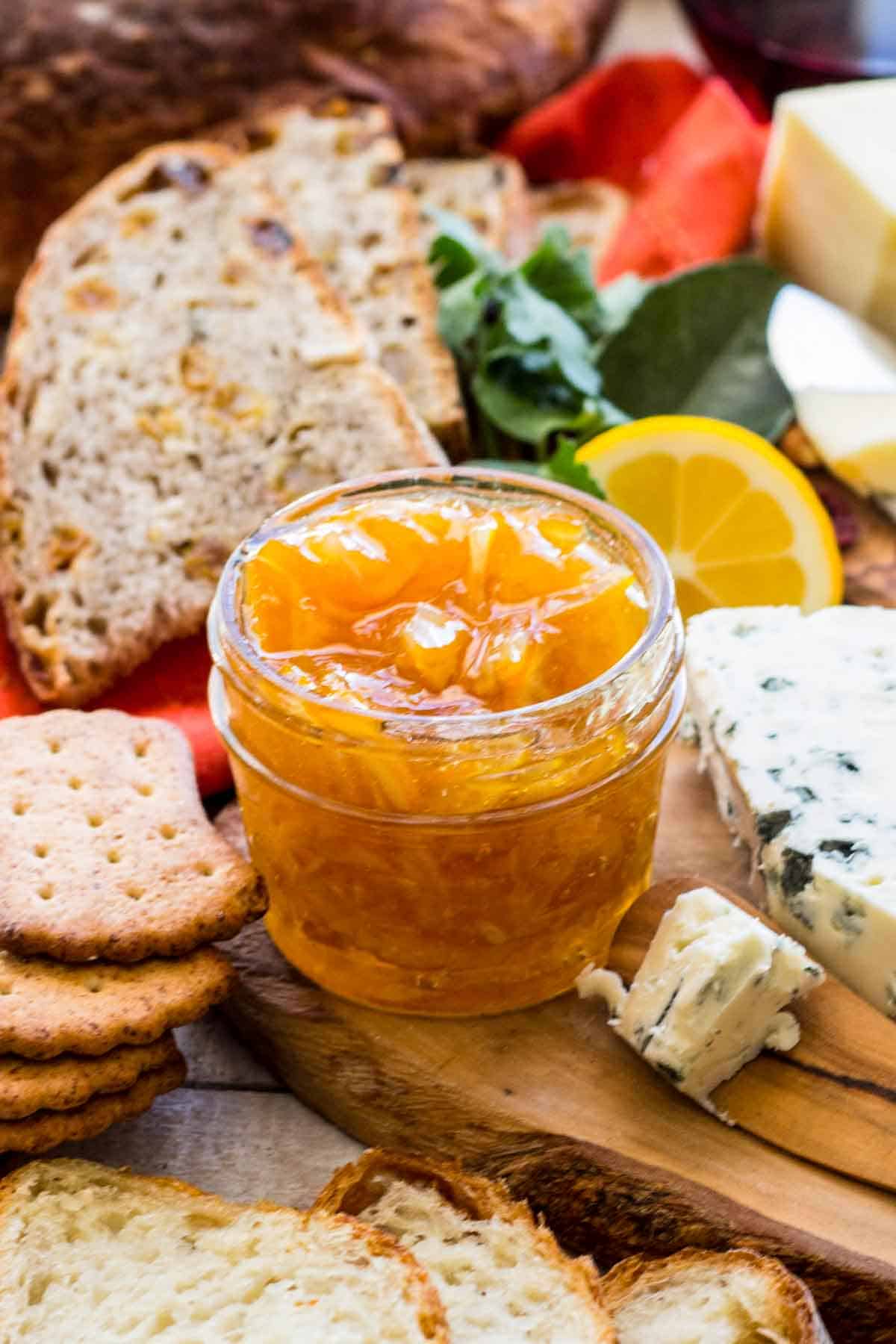
This bright marmalade recipe, marmellata di limoni, is a great way to celebrate citrus season. Unlike traditional orange marmalade or tart lemon marmalades made with Lisbon or regular lemons, this version uses Meyer lemons to be softer and sweeter.
Meyer lemons are a cross between standard lemons and Mandarin oranges, which gives them a floral fragrance and less acidity. This recipe takes full advantage of that complexity by incorporating every part of the fruit, including the peel, for a citrus marmalade that’s bold and balanced.
The fruit pulp and natural oils in the peel provide not only flavor but the pectin needed for that classic gel-like consistency. The lemon peel pieces add texture and depth, while the pulp and juice bring brightness.
Have profuse amounts of lemons from your Meyer lemon trees? If you've never made a homemade marmalade before, this easy recipe is a great place to start!
What is Marmalade?
Marmalade is a fruit preserve made from the peel, pulp, and juice of whole citrus, cooked down with sugar and water until thick and glossy. It's a creative way to preserve whole fruit without waste.
The skin, juice, and pulp all contribute their own flavor and texture. When you use the peel of citrus fruits, you get a slightly bitter bite that offsets the sweetness.
Marmalade vs. Jam
While both spreads fall under the fruit preserve family, marmalade and jam differ in both ingredients and texture. Jam typically uses crushed or puréed fruit and is smooth and uniform.
Marmalade, however, includes the peel, pulp, and juice, resulting in a chunky, chewy, and slightly bitter spread with a little bit more complex flavor profile.
For more Meyer lemon recipes, try my herb-roasted fish with Meyer lemon vinaigrette, this sweet and savory Meyer lemon focaccia, or these tangy Meyer lemon cookies.
Why This Recipe Works
- Uses the whole lemon, maximizing both flavor and texture.
- No need for store-bought pectin, only basic pantry staples needed.
- Uses a simple technique for checking the setting point without special tools.
- Makes a small batch, ideal for first-time marmalade makers!

Ingredient Notes
Meyer Lemons – These lemons are essential for their low acidity and floral-sweet flavor. If unavailable, use half lemon juice and half mandarin orange juice, plus the zest of both. Their thin peel is less bitter than Lisbon lemons, making them ideal for marmalade.
Sugar – Essential for setting the marmalade and preserving it. Avoid using less sugar in jam making; the classic ratio of fruit to sugar is crucial to achieving the correct consistency and preserving quality.
Cardamom Pods – Optional but recommended. Lightly crushed and simmered in the mixture, they introduce a subtle floral spice. A pinch of ground cardamom will work well, too.
Salt – A small pinch enhances all the other flavors and balances the sweetness.
Water – Use filtered or cold water to combine with the lemon mixture. The number of cups of water used here plays a critical role in the final texture, so measure carefully.
*Find the full ingredient list in the recipe card below!
Helpful Equipment
- Sharp knife
- Medium saucepan or wide pot
- Cheesecloth
- Kitchen twine
- Canning jars or mason jars
- Candy thermometer (optional)
How to make lemon marmalade
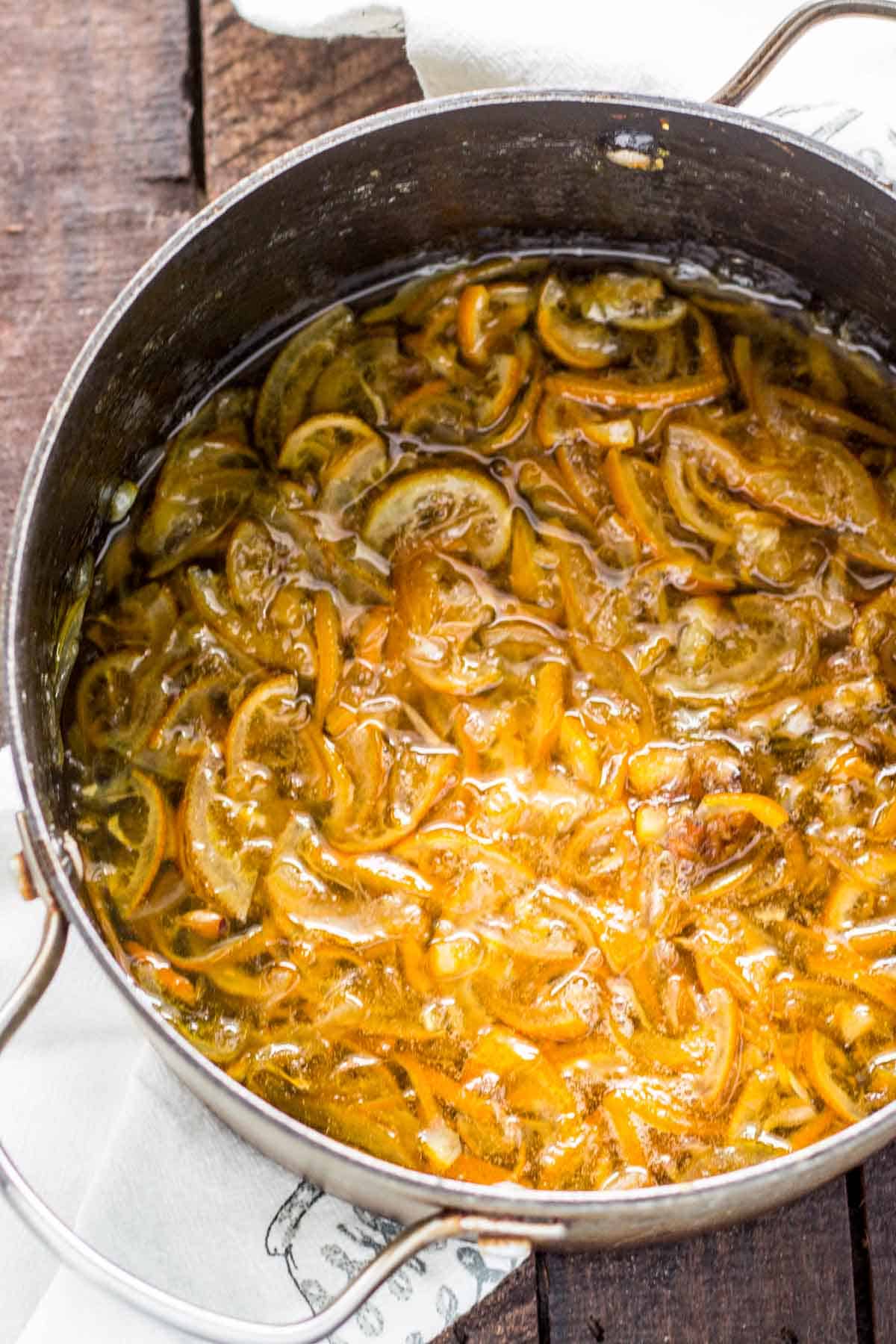
- Wash the lemons thoroughly under cold water to remove any dirt or wax. This step is essential if the lemons have been coated for storage, especially those from the grocery store.
- Cut each lemon in half lengthwise, then use a sharp knife to remove the white pithy core from the center. The pith is bitter and can affect the flavor of your citrus marmalade.
- Scoop out and reserve the seeds—they're essential for thickening the marmalade naturally.
Pro Tip: Lemon seeds contain natural pectin, which helps your marmalade set without the need for extra pectin.
- Cut each lemon half into quarters lengthwise, then slice each quarter into very thin slices. The thinner the slices, the more tender the lemon peel pieces will be in the finished marmalade.
- Transfer the lemon slices to a large pot. Add the sugar, cups of water, and salt, stirring to combine. Stir until the sugar begins to dissolve.
- Place the reserved lemon seeds and the crushed cardamom pods (if using) into a square of cheesecloth. Tie it into a sachet with kitchen twine and add it to the pot. This acts as your homemade pectin bag.
- Bring the mixture to a rolling boil over high heat. Stir frequently with a wooden spoon to prevent scorching the bottom of the pan.
- Once boiling, reduce the heat to a steady simmer. You want to maintain a gentle, but strong boil until you reach jelly temperature. Cook uncovered for about 20–25 minutes, stirring occasionally, until the mixture has thickened and the lemon peels are translucent and tender.
Pro Tip: Test for doneness using the wrinkle test: Drop a small amount of the marmalade onto a chilled plate and wait a few seconds. Push it gently with your finger—if it wrinkles, it’s set. This is a good sign your marmalade has reached the proper setting point.
- Once the marmalade reaches the proper consistency and passes the wrinkle test, remove the pot from the heat and discard the sachet.
- Carefully ladle the hot marmalade into sterilized canning jars, leaving about ¼ inch of headspace. Wipe the rims clean with a wet paper towel, apply the lids, and seal tightly. Let the jars cool at room temperature before refrigerating or processing in a boiling water bath for longer storage.
Tips for Success
- Use a wide pot for faster evaporation and better temperature control.
- Stir often to avoid burning the fruit pulp at the bottom.
- If you’re unsure about the texture, use a candy thermometer to reach 220°F.
- Test often to avoid overcooking. A blob of hot marmalade should slowly ooze on a cold plate.

Variations
- Add thinly sliced ginger during cooking for a zesty edge.
- Use blood oranges or sour oranges for a bold color and deeper bitterness.
- Include a sliver of cinnamon stick or vanilla during cooking for warm spice.
- Blend with Seville or bitter oranges for a more complex citrus flavor.
What to Serve with Lemon Marmalade
Enjoy this homemade lemon marmalade recipe on the breakfast table with freshly made popovers or warm, flaky Irish biscuits, buttered crispy waffles, golden homemade focaccia, spooned over blueberry ricotta pancakes or stirred into thick Greek yogurt. Or, use it as a glaze for roasted chicken or salmon!
It also makes a stunning addition to cheese boards since it pairs well with sharp cheeses and crusty bread.
Storage Tips
Store in the fridge for up to 1 month. For longer shelf life, process sealed jars in boiling water for 10 minutes using a water bath canner. Let cool, then store in a cool, dark place for up to 6 months. Be sure to follow all sanitation and safety procedures when canning.
Label jars with the date and refrigerate once opened. If your jam cools too soft, you can reboil to firm it up. This recipe makes a couple jars, perfect for gifts or enjoying slowly through the season.
FAQs
It may have cooked too long or reached a higher temperature than needed. Always test early to avoid overcooking by pouring a little marmalade into a chilled small plate. If you prefer a soft set, this will be the best way to stop cooking at right time.
You can, but it will take longer to cook since larger volumes take longer to reach the boiling point and may not set as well. It's best if split into two pots.
This could mean you didn’t dissolve all the sugar. Try dissolving it fully before bringing to a rapid boil.
Not quite. Lemon curd includes eggs and butter, while this homemade lemon marmalade is all about the whole fruit and citrus peel.
Did you LOVE this recipe? Please leave a star ⭐️ rating and comment and tag your creations @ColeyCooks on Instagram!
Want to Save This Recipe?
Enter your email & I'll send it to your inbox.
By submitting this form, you consent to receive emails from Coley Cooks.
Meyer Lemon Marmalade
Ingredients
- 4 medium Meyer lemons
- 2 cups granulated sugar
- 2 cups water
- 1 pinch of salt
- 5 green cardamom pods lightly crushed (optional)
Instructions
- Wash the Meyer lemons thoroughly. Slice each one in half lengthwise.
- Use a knife to remove the white pith that runs down the center of each half, then use your fingers to scoop out any seeds. Set the seeds aside.
- Cut each lemon half in half again lengthwise, then slice each quarter into very thin slices—use a sharp knife and slice as thinly as possible.
- Place the lemon slices in a medium saucepan along with the sugar, water, and salt.
- Wrap the reserved lemon seeds and lightly crushed green cardamom pods in a small piece of cheesecloth, then tie it closed with kitchen twine. Add the sachet to the pot.
- Bring the mixture to a boil over medium-high heat. Once boiling, reduce the heat to a simmer and cook for about 20 minutes, or until the lemons have broken down and the liquid has reduced to a thick, syrupy consistency.
- Remove from heat and let cool. Discard the sachet of seeds and cardamom pods.
- Transfer the marmalade to a jar or jars. Cover and refrigerate for up to 1 month.
Notes
- Use a wide pot for faster evaporation and better temperature control.
- Stir often to avoid burning the fruit pulp at the bottom.
- If you’re unsure about the texture, use a candy thermometer to reach 220°F.
- Test often to avoid overcooking. A blob of hot marmalade should slowly ooze on a cold plate.


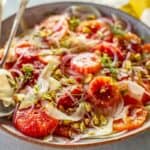
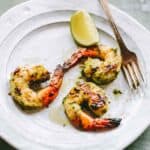
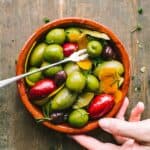
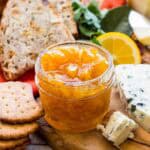
No comments since 2016??? I cannot wait to make this! Not only does it look beautiful in your photo simmering but I imagine it smells heavenly, too. I need that slice of bread with this jam and piece of blue cheese ~ yum
Thank you!! Yes, it's a very old recipe but I'm so glad you found it! It's sooo good with blue cheese 😉
Wait just a cotton-pickin' minute.... YOU have a Meyer Lemon tree??? Do you keep it in your house? I have so many questions about that now! The cheeses are BEAUTIFUL!!! Your presentation looks fabulous and the suggestions on display are really helpful, Coley. I DO have a suggestion, though. The closeups are great, but I really would liked to have seen the Full Monty (so to speak).. just to get an idea of how much space you used with all the different cheeses and condiments and greenery. Maybe next time? Please? LOVE ALL of your posts, babe! Also... thanks to Castello for the sponsor and sweepstakes... how fun is that!?!
Yes! It's a bit sick at the moment, which is why I had to harvest all the lemons. I keep it outside when its warm, so this year it didn't come inside until January. I bought it last fall from Liz, the garden goddess, so I'm sure you could inquire to see if she has any more for sale. I love it. Takes a long time to produce lemons, but they are so fresh and juicy and delicious! Will tell you all about it next time I see ya. As for the photos, thank you for the suggestion!! It's actually stemming from a bigger problem I'm currently trying to figure out, which is the placement of my window and table where i take the photos. It's up too high, so getting a good birds eye shot of a big area like this one is near impossible - I'd have to break through the ceiling! I tried taking some, but the ones that came close to showing everything were really blurry. Chaser and I are planning to switch offices at some point, in which case my little studio area will be getting a makeover. I'm hoping it happens sooner than later! That being said, your cheese platter should always be designed around YOUR space and YOUR style! Use mine as inspiration and let your imagination help you create something even more inviting. 🙂
You're the BEST!!! Thanks!
Hi there, I'm sorry to just be getting back to you, but yes, i think that you palrbboy got an overripe cheese. That's too bad, and well worth talking to the store about. If they're good cheesemongers, I'd think they would reimburse you in $ or in a fresher cheese. You're right that cheese is spendy: good cheese takes milk from responsibly raised cows, the skills of an experienced cheesemaker, and time, so I look at artisanal cheese, big or small as a an occasional treat that supports a lot of good people. You're right though that you can often get a great deal on cheeses cut from larger wheels my fave local cheesemonger has a basket of cheese ends that's a wonderful resource.
That's my heaven!!! I would happily live on it forever and ever. Your Meyer lemons are so photogenic. I never knew the seeds were useful for pectin. Very cool. I'm making calamondin marmalade today, so I'll use that trick. Now fingers crossed for my trip to Napa...
Oh, my fingers are so crossed for you to win that trip, too! Napa is so amazing. I learned about the lemon seed trick a few years ago when I was making a plum jam. Still no idea if it actually makes a difference, but it can't hurt, right? I'm not all that jam savvy. Would love to try a calamondin one of these days! You have such amazing fruits growing in your backyard!